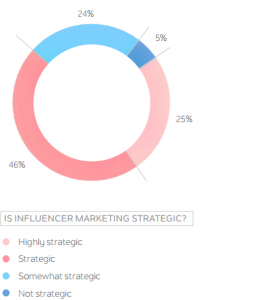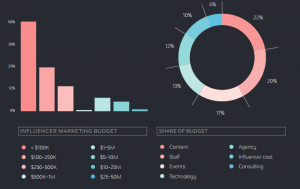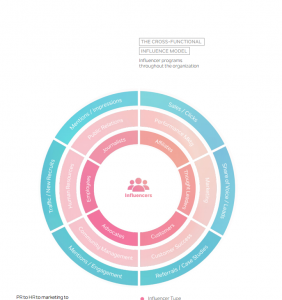by Sudipto Ghosh, Martech Series
Traackr, the leading influencer marketing analytics software provider released a comprehensive global report titled “Influence 2.0: The Future of Influencer Marketing”, evaluating the status of influencer marketing across top enterprises. The latest global research report Influence 2.0 serves the purpose of pushing marketers forward, leveraging the best practices of influencer marketing to gain meaningful relationship-driven ROI. Traackr partnered with TopRank Marketing and Brian Solis at Altimeter to release the latest influencer marketing report.
TRAACKR’S INFLUENCE 2.0 REPORT: GROUND-BREAKING OBSERVATIONS
The report features a survey of 102 global enterprise marketers and brand strategists, enquiring about how each one of them nurtures relationships with influencers over time. Influencer programs should drive digital transformation and build an intimate personalized relationship with the customers.

via Influence 2.0
“The business of influence is maturing and proving to be a driving force in enterprise growth and digital transformation,” said Traackr CEO, Pierre-Loic Assayag. “CMOs must make Influence 2.0 a priority investment now to harness this power and lead in redefining the impact of marketing in the enterprise business.”
Ergo, Influence 2.0 identifies the goals of influencer programs, helping companies:
- Improve brand advocacy
- Expand brand awareness
- Reach new target audiences
- Increase share of customer’s voice
- Improve sales conversion
- Manage brand reputation
- Drive lead generation
- Accelerate digital transformation
- Improve customer satisfaction
- Improve employee’s influence
WHERE MARKETERS PLACE INFLUENCER CAMPAIGNS?
Influence is defined as the force that causes a change in the behavior. However, modern influencer marketing strategies are unable to accomplish it. 43% of marketers are still experimenting with influencer marketing; 28% utilize influencers only at the campaign level.
Influencer relationships rank first in the list of marketing disciplines that catalyze digital transformation with a humanistic approach. 47% respondents agree that influencer activities will become cross-functional, surpassing marketing objectives.
Marketers segment influencers into tactical and long-term agents. Only 24% marketers run “always-on” influencer marketing program. About 5% have integrated influencers into all marketing activities.

via Influence 2.0
Influencer marketing, though in its nascent stage of adoption, is hugely driven by automation technology. Low investment in influencer marketing reflects a grim lack of strategic prioritization. Most enterprises allocate have annual influencer marketing budget of less than $100,000.
The true power of influencer marketing lies with the influencer’s network connections, long-term collaboration, advocacy on quality, the authenticity of understanding, and trusted content.
DISCONNECTED PROGRAM LEADERS HURT EFFECTIVENESS OF INFLUENCE CAMPAIGNS
Influencer marketing is pivotal in driving human-centric change across the enterprise. Enterprises fail 7 out of 10 times in their attempt to drive digital transformation due to lack of endorsement from leaders and fragmented collaboration with employee base.
Currently, influencer program leaders and implementers are disconnected on tactics and strategies. Influence 2.0 report advocates a dedicated team for brands looking to scale its social influencer relations. The influencer marketing ownership is currently attributed to marketing and PR department, followed by social media and digital marketing teams. However, social media department engages the highest with influencers compared to others.
According to Bryan Kramer, CEO at PureMater, Influencer marketing transcends the traditional boundaries of B2B and B2C. Kramer says, “There is no more B2B or B2C: It’s Human to Human, #H2H. Social and marketing need to work together to personalize individual conversations, as well as deliver shared global experiences that crowds of common values can benefit from.”
IDEAL CONTENT EXPERIENCE DRIVEN POWERED BY INFLUENCERS
For content publishers, influence is an ideal partner complementing customer journey mapping process through engaging content, community rendezvous, and precision decision-making. Overall, investing in influence significantly improves content experience during new product introductions, demonstrations and problem-solving processes.
The report invites enterprise CMOs to reimagine their role as the central driver and enabler of this process, taking the lead in digital transformation. But it highlights that influence still has some work ahead to develop and mature as a practice, become a top priority at board level and be recognized for this role.
INTRODUCING CROSS-FUNCTIONAL INFLUENCE MODEL FOR ENTERPRISES
Taking a leap of faith into cross-functional influencer marketing, the report suggests a visual model enabling marketers to deploy marketing strategies with contemporary social tactics.

Cross-functional Influence Marketing Model via Influence 2.0 Report
COMMENTS FROM BRIAN SOLIS ON INFLUENCE 2.0 REPORT
“Influence 2.0 is an incredible opportunity for marketers to think differently about customer experience to fast track the inevitable changes that digital business presents,” said Brian Solis, Principal Analyst at Altimeter. “Marketers must reimagine their role as a central driver of organizational change, output, and impact by connecting with customers in more genuine and useful ways and on channels they trust and value.”
Solis states that harnessing influence requires a more human approach with empathy and customer-centricity instrumental in taking influence to the next level. He pins success on reassessing the value chain around creating value within the relationships between influencers and their communities.
“A more customer-centric approach to marketing fueled by influencer relationships has universal applications in enterprise organizations,” said Lee Odden, CEO of TopRank Marketing. “The insights in this report provide an excellent framework for senior business leaders to evolve their digital practices from content to customer service.”


Leave a Reply